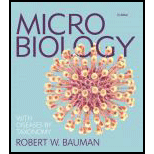
1.
To determine:
The correct description associated with goblet cells.
Introduction:
The “immune system” includes “three lines of defense” against foreign body: “physical and chemical barriers”, nonspecific resistance, and specific resistance. The first lines of defense are the physical and chemical barriers, which are considered functions of innate immunity.
2.
To determine:
The correct description associated with lysozyme.
Introduction:
The “immune system” includes “three lines of defense” against foreign body: “physical and chemical barriers”, nonspecific resistance, and specific resistance. The first lines of defense are the physical and chemical barriers, which are considered functions of innate immunity.
3.
To determine:
The description associated with stem cells.
Introduction:
The “immune system” includes “three lines of defense” against foreign body: “physical and chemical barriers”, nonspecific resistance, and specific resistance. The first lines of defense are the physical and chemical barriers, which are considered functions of innate immunity.
4.
To determine:
The description associated with dendritic cells.
Introduction:
The “immune system” includes “three lines of defense” against foreign body: “physical and chemical barriers”, nonspecific resistance, and specific resistance. The first lines of defense are the physical and chemical barriers, which are considered functions of innate immunity.
5.
To determine:
The description associated with cells from sebaceous glands.
Introduction:
The “immune system” includes “three lines of defense” against foreign body: “physical and chemical barriers”, nonspecific resistance, and specific resistance. The first lines of defense are the physical and chemical barriers, which are considered functions of innate immunity.
6.
To determine:
The description associated with bone marrow stem cells.
Introduction:
The “immune system” includes “three lines of defense” against foreign body: “physical and chemical barriers”, nonspecific resistance, and specific resistance. The first lines of defense are the physical and chemical barriers, which are considered functions of innate immunity.
7.
To determine:
The description associated with eosinophils.
Introduction:
The “immune system” includes “three lines of defense” against foreign body: “physical and chemical barriers”, nonspecific resistance, and specific resistance. The first lines of defense are the physical and chemical barriers, which are considered functions of innate immunity.
8.
To determine:
The description associated with alveolar macrophages.
Introduction:
The “immune system” includes “three lines of defense” against foreign body: “physical and chemical barriers”, nonspecific resistance, and specific resistance. The first lines of defense are the physical and chemical barriers, which are considered functions of innate immunity.
9.
To determine:
The description associated with microglia.
Introduction:
The “immune system” includes “three lines of defense” against foreign body: “physical and chemical barriers”, nonspecific resistance, and specific resistance. The first lines of defense are the physical and chemical barriers, which are considered functions of innate immunity.
10.
To determine:
The description associated with wandering macrophages.
Introduction:
The “immune system” includes “three lines of defense” against foreign body: “physical and chemical barriers”, nonspecific resistance, and specific resistance. The first lines of defense are the physical and chemical barriers, which are considered functions of innate immunity.
Want to see the full answer?
Check out a sample textbook solution
Chapter 15 Solutions
Microbiology with Diseases by Taxonomy (5th Edition)
- In one paragraph show how atoms and they're structure are related to the structure of dna and proteins. Talk about what atoms are. what they're made of, why chemical bonding is important to DNA?arrow_forwardWhat are the structure and properties of atoms and chemical bonds (especially how they relate to DNA and proteins).arrow_forwardThe Sentinel Cell: Nature’s Answer to Cancer?arrow_forward
- Molecular Biology Question You are working to characterize a novel protein in mice. Analysis shows that high levels of the primary transcript that codes for this protein are found in tissue from the brain, muscle, liver, and pancreas. However, an antibody that recognizes the C-terminal portion of the protein indicates that the protein is present in brain, muscle, and liver, but not in the pancreas. What is the most likely explanation for this result?arrow_forwardMolecular Biology Explain/discuss how “slow stop” and “quick/fast stop” mutants wereused to identify different protein involved in DNA replication in E. coli.arrow_forwardMolecular Biology Question A gene that codes for a protein was removed from a eukaryotic cell and inserted into a prokaryotic cell. Although the gene was successfully transcribed and translated, it produced a different protein than it produced in the eukaryotic cell. What is the most likely explanation?arrow_forward
- Molecular Biology LIST three characteristics of origins of replicationarrow_forwardMolecular Biology Question Please help. Thank you For E coli DNA polymerase III, give the structure and function of the b-clamp sub-complex. Describe how the structure of this sub-complex is important for it’s function.arrow_forwardMolecular Biology LIST three characteristics of DNA Polymerasesarrow_forward
 Medical Terminology for Health Professions, Spira...Health & NutritionISBN:9781305634350Author:Ann Ehrlich, Carol L. Schroeder, Laura Ehrlich, Katrina A. SchroederPublisher:Cengage Learning
Medical Terminology for Health Professions, Spira...Health & NutritionISBN:9781305634350Author:Ann Ehrlich, Carol L. Schroeder, Laura Ehrlich, Katrina A. SchroederPublisher:Cengage Learning Cardiopulmonary Anatomy & PhysiologyBiologyISBN:9781337794909Author:Des Jardins, Terry.Publisher:Cengage Learning,
Cardiopulmonary Anatomy & PhysiologyBiologyISBN:9781337794909Author:Des Jardins, Terry.Publisher:Cengage Learning,





